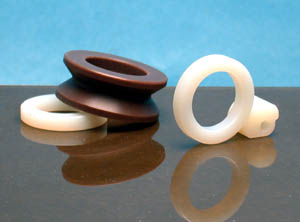Plastic Properties of Nylon (Polyamide)

|
| Hinge bearings, bushings and pulley sheves machined out of various colors of nylon. |
Nylon (Polyamide), invented in 1928 by Wallace Carothers (DuPont) is considered to be the first engineering thermoplastic. It is one of many heterochain thermoplastics which has atoms other than C in the chain. Nylon is created when a condensation reaction occurs between amino acids, dibasic acids and diamines. Commercially Nylon is commonly used in the production of tire cords, rope, belts, filter cloths, sports equipment and bristles. It is particularly useful when machined into bearings, gears, rollers and thread guides.

Dynalab Corp's plastic fabrication shop fabricates many catalog and custom Nylon products. If you can't find the product you require on our website please e-mail for a custom quote.
Don't see the answers to your Nylon questions? It must be time to see what
Mr. Plastic has to say. Mr. Plastic is a wealth of technical, practical and even some hysterical plastic advice. Please submit your request via
e-mail, phone calls will not be accepted.
Nylon Resistance:
|
|
Nylon Quick Facts:
|
Excellent resistance (no attack) to Oils, Bases and THF
|
|
• Max Temp: 210°F 99°C
• Min Temp: --94°F -70°C
• Autoclavable: No
• Melting Point: 420°F 216°C
• Tensile Strength: 5,800 psi
|
• Hardness: R92
• UV Resistance: Good
• Translucent
• Rigid
• Specific Gravity: 1.13 |
Good resistance (minor attack) to to Solvents, Formaldehyde and Alcohols
|
|
Limited resistance (moderate attack and suitable for short term use only) to Dilute Acids
|
|
Poor resistance (not recommended for use with) Phenols, Alkalis, Iodine and Acids
|
|
| Nylon Fabrication: |
|
Additional Information:
|
• Excellent material for machining
• Tough, strong, and impact resistant material
• Very low coefficient of friction
• Abrasion resistant
|
|
• Chemical Properties A-F
• Chemical Properties G-Z
• Physical Properties
• Use and Care of Plastics
The downloads above are
Adobe PDF files and require
Adobe Acrobat Reader
|
|
|